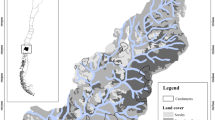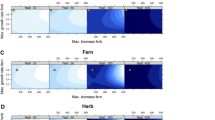Abstract
In this study, we assessed the role of forests in the local water budget within a 7.3 km2 catchment that has measured river runoff and a long history of forest exploitation and disastrous flooding and debris flow events. Forests retain and absorb water from turning into runoff which is a possible trigger for catastrophic events. Forest water budgets (i.e. interception, transpiration, evaporation, sublimation, soil water storage and outflow) interact with ecosystem processes that are related to the carbon, nutrient and energy cycles and consequently affect forest growth rates. Therefore, we employed a biogeochemical–mechanistic ecosystem model, Biome-BGC, as a diagnostic tool to evaluate the dynamic relationships between key forest ecosystem characteristics and the water cycle. Our study was conducted in the Schmittental catchment with about 70 % forest coverage, situated in the Greywacke Zone of the Austrian Alps. Using stand and site information from 21 Norway spruce stands from the region and 29 years of total catchment runoff data for model validation, we demonstrated that the process-based ecosystem model mimics the interaction of forest growth and the water budget realistically. The weekly catchment runoff calculations based on Biome-BGC grid simulations compared well with observed runoff data. The analysis of the forest–water dynamics/relations showed that the water budget is affected by the size of the canopy and the physiological canopy behaviour in response to daily weather. The results suggested that for fully stocked stands and with a standing volume of >250 m3 ha−1, forest water outflow was minimised.









Similar content being viewed by others
References
Aigner J (1991) Wurzelraum eines sekundären Fichtenbestandes im tertiären Hügelland Oberösterreichs (Root zone of a secondary spruce stand in the tertiary hills of Upper Austria). Master thesis, University of Natural Resources and Life Sciences, Vienna
Badoux A, Witzig J, Germann PF et al (2006) Investigations on the runoff generation at the profile and plot scales, Swiss Emmental. Hydrol Process 20:377–394. doi:10.1002/hyp.6056
Beckers J, Smerdon B, Wilson M (2009) Review of hydrologic models for forest management and climate change applications in British Columbia and Alberta. FORREX, Kamloops, BC. FORREX Series Report No. 25
Berger F, Rey F (2004) Mountain protection forests against natural hazards and risks: New French developments by integrating forests in risk zoning. Nat Hazards 33:395–404. doi:10.1023/B:NHAZ.0000048468.67886.e5
Bitterlich W (1948) Die Winkelzählprobe (The angle-count sample). Allg Forst- und Holzwirtschaftszeitung 59:4–5
Bobeva A (2003) Quantifying the distribution of forest functional types and forest. PhD thesis, University Bayreuth
Brang P, Schönenberger W, Ott E, Gardner B (2001) Forests as protection from natural hazards. In: Evans J (ed) For. Handb. Blackwell Science, Oxford, pp 53–81
Clapp RB, Hornberger GM (1978) Empirical equations for some soil hydraulic properties. Water Resour Res 14:601–604. doi:10.1029/WR014i004p00601
Cosby BJ, Hornberger GM, Clapp RB, Ginn TR (1984) A statistical exploration of the relationships of soil moisture characteristics to the physical properties of soils. Water Resour Res 20:682–690. doi:10.1029/WR020i006p00682
Eastaugh CS, Pötzelsberger E, Hasenauer H (2011) Assessing the impacts of climate change and nitrogen deposition on Norway spruce (Picea abies L. Karst) growth in Austria with BIOME-BGC. Tree Physiol 31:262–274. doi:10.1093/treephys/tpr033
Engler A (1919) Untersuchungen über den Einfluß des Waldes auf den Stand der Gewässer (Studies on the influence of the forest on the state of waterbodies). Mitteilungen der Schweizerischen Zentralanstalt für das forstliche Versuchswesen 12
Enting IG, Wigley TML, Heimann M, Scientific C (1994) Future emissions and concentrations of carbon dioxide: key ocean/atmosphere/land analyses. Division of Atmospheric Research Technical Paper no. 31. CSIRO, Australia
Geitner C, Mergili M, Lammel J et al (2009) Modelling peak runoff in small Alpine catchments based on area properties and system status. In: Veulliet E, Johann S, Weck-Hannemann H (eds) Sustainable natural hazard management in alpine environments. Springer, Berlin, pp 103–134
Gower ST, Kucharik CJ, Norman JM (1999) Direct and indirect estimation of Leaf Area Index, f APAR, and net primary production of terrestrial ecosystems. Remote Sens Environ 70:29–51
Hagen K (2003) Wildbacheinzugsgebiet Schmittenbach (Salzburg)—Analyse des Niederschlags- und Abflussgeschehens 1977–1998 (Torrential Watershed of Schmittenbach (Salzburg)—Analysis of Precipitation and Runoff). BFW Berichte 129:101
Hamilton L (1992) The protective role of mountain forests. GeoJournal. doi:10.1007/BF00150632
Hasenauer H, Burgmann M, Lexer MJ (2000) Concepts within forest ecosystem modeling. Cent für das gesamte Forstwes 117:137–164
Hasenauer H, Merganicova K, Petritsch R et al (2003) Validating daily climate interpolations over complex terrain in Austria. Agric For Meteorol 119:87–107. doi:10.1016/S0168-1923(03)00114-X
Hinterstoisser H (1985) Die forstliche Problematik intensiver Wintersporterschließung am Beispiel der Schmittenhöhe, Zell am See (The silvicultural problem of intensive winter sports development on the example of the Schmittenhöhe, Zell am See). Mitteilungen der Gesellschaft für Salzburg. Landeskunde, Salzbg
IPCC (1992) Climate change 1992: the supplementary report to the IPCC scientific assessment. Cambridge University Press, Cambridge
Kilian W, Müller F, Starlinger F (1994) Die forstlichen Wuchsgebiete Österreichs (The Forest Ecoregions of Austria). BFW-Berichte 82:60
Lange B, Germann PF, Lüscher P (2010) Einfluss der Wurzeln auf das Wasserspeicher vermögen hydromorpher Waldböden (Significance of roots for soil water storage capacity of hydromorphic forest soils). Schweizerische Zeitschrift für Forstwes 161:510–516
Markart G, Kohl B, Perzl F (2006) Der Bergwald und seine hydrologische Wirkung - eine unterschätzte Größe? (The mountain forest and its hydrological function—an underestimated factor?). LWF Wissen 55:34–43
Marschall J (1975) Hilfstafeln für die Forsteinrichtung (Yield tables for forest planning). Österreichischer Agrarverlag
Merganičová K, Pietsch SA, Hasenauer H (2005) Testing mechanistic modeling to assess impacts of biomass removal. For Ecol Manage 207:37–57. doi:10.1016/j.foreco.2004.10.017
Merganičová K, Merganic J, Hasenauer H (2012) Assessing the carbon flux dynamics within Virgin forests. Austrian J For Sci 129:1–21
Olschewski R, Bebi P, Teich M et al (2012) Avalanche protection by forests—a choice experiment in the Swiss Alps. For Policy Econ 15:108–113. doi:10.1016/j.forpol.2011.10.002
Pallardy SG (2008) Physiology of woody plants, 3rd ed. doi:10.1016/B978-012088765-1.50015-4
Petritsch R (2008) Large scale mechanistic ecosystem modeling in Austria. PhD thesis, University of Natural Resources and Life Sciences, Vienna
Petritsch R, Hasenauer H (2007) Interpolating input parameters for large scale ecosystem models. Austrian J For Sci 124:135–151
Petritsch R, Hasenauer H (2014) Climate input parameters for real-time online risk assessment. Nat Hazards 70:1749–1762. doi:10.1007/s11069-011-9880-y
Petritsch R, Hasenauer H, Pietsch SA (2007) Incorporating forest growth response to thinning within biome-BGC. For Ecol Manage 242:324–336. doi:10.1016/j.foreco.2007.01.050
Pietsch SA, Hasenauer H (2002) Using mechanistic modeling within forest ecosystem restoration. For Ecol Manage 159:111–131. doi:10.1016/S0378-1127(01)00714-9
Pietsch SA, Hasenauer H (2006) Evaluating the self-initialization procedure for large-scale ecosystem models. Glob Chang Biol 12:1658–1669. doi:10.1111/j.1365-2486.2006.01211.x
Pietsch SA, Hasenauer H, Thornton PE (2005) BGC-model parameters for tree species growing in central European forests. For Ecol Manage 211:264–295. doi:10.1016/j.foreco.2005.02.046
Placer K, Schneider J (2001) Arbeiten zur Kartierung der trockenen Deposition in Österreich (Studies on the mapping of dry deposition in Austria). Fed Environ Agency, Austria
Pollanschütz J (1971) Auswertung von Waldinventur (Analysis of forest inventory). 100 Jahre Hochschule für Bodenkultur. Vienna, pp 355–368
Reineke LH (1933) Perfecting a stand density index for even-aged forests. J Agric Res 46:627–638
Reynolds MR (1984) Estimating the error in model predictions. For Sci 30:454–469
Running SW (1992) A bottom-up evolution of terrestrial ecosystem modeling theory, and ideas toward global vegetation modeling. Univ Corp Atmos Res Model Earth Syst 3:263–280
Saxton KE, Rawls WJ, Romberger JS, Papendick RI (1986) Estimating generalized soil–water characteristics from texture. Soil Sci Soc Am J 50:1031. doi:10.2136/sssaj1986.03615995005000040039x
Schaffhauser H (1982) Untersuchungen über das Abflussverhalten verschieden bewirtschafteter Versuchsflächen (Studies on the outflow behaviour of differently managed experimental areas). Mitteilungen der Forstl Bundesversuchsanstalt, Wien 144:85–102
Schmittenhöhebahn AG (2014) Skiing and snowboarding. http://www.schmitten.at. Accessed 26 March 2014
Schneider J (1998) Kartierung der nassen Deposition in Österreich (Mapping of the wet deposition in Austria). Fed Environ Agency, Austria
Sidle RC, Pearce AJ, O’Loughlin CL (1985) Hillslope stability and land use. Water Resour Monogr. 11. AGU, Washington, DC
Sonnier J (1991) Analyse du rôle de protection des forêts domaniales de montagne (Analysis of the role of protecting the state mountain forests). Rev For Française 43:131–145
Thoma R (1900) Berichte des Forst-Vereins für Oberösterreich und Salzburg (Reports of the forest association for Upper Austria and Salzbur), 40. Band. Forstverein für Oberösterreich und Salzburg, Gmunden
Thornton PE (1998) Regional ecosystem simulation: combining surface- and satellite-based observations to study linkages between terrestrial energy and mass budgets. PhD thesis, University of Montana, Missoula
Thornton PE, Running SW, White M (1997) Generating surfaces of daily meteorological variables over large regions of complex terrain. J Hydrol 190:214–251. doi:10.1016/S0022-1694(96)03128-9
Thornton PE, Hasenauer H, White M (2000) Simultaneous estimation of daily solar radiation and humidity from observed temperature and precipitation: an application over complex terrain in Austria. Agric For Meteorol 104:255–271. doi:10.1016/S0168-1923(00)00170-2
Thornton PE, Law BE, Gholz HL et al (2002) Modeling and measuring the effects of disturbance history and climate on carbon and water budgets in evergreen needleleaf forests. Agric For Meteorol 113:185–222. doi:10.1016/S0168-1923(02)00108-9
Uddling J, Teclaw RM, Kubiske ME et al (2008) Sap flux in pure aspen and mixed aspen-birch forests exposed to elevated concentrations of carbon dioxide and ozone. Tree Physiol 28:1231–1243
Warren JM, Pötzelsberger E, Wullschleger SD et al (2011) Ecohydrologic impact of reduced stomatal conductance in forests exposed to elevated CO2. Ecohydrology 4:196–210. doi:10.1002/eco.173
Wehrli A, Brang P, Maier B et al (2007) Schutzwaldmanagement in den Alpen—eine Übersicht (Management of protection forests in the Alps—an overview). Schweizerische Zeitschrift fur Forstwes 158:142–156. doi:10.3188/szf.2007.0142
White M, Thornton PE, Running SW, Nemani RR (2000) Parameterization and sensitivity analysis of the BIOME–BGC terrestrial ecosystem model: net primary production controls. Earth Interact 4:1–85. doi:10.1175/1087-3562(2000)004<0003:PASAOT>2.0.CO;2
WLV (1996) Technischer Bericht des Flächenwirtschaftlichen Projektes Schmittenbach (Technical report of the management project river Schmittenbach). Wildbach- und Lawinenverbauung (WLV)—Forsttechnischer Dienst—Gebietsbauleitung Pinzgau, Zell am See
Acknowledgments
Data on river Schmittenbach runoff for the years 1981–2005 were provided by the Federal Research and Training Centre for Forests, Natural Hazards and Landscape (BFW). 2003–2009 runoff data were provided by the Institute of Mountain Risk Engineering (IAN) of the University of Natural Resources and Life Sciences, Vienna. We are grateful to the ‘Landschaftliche Forstverwaltung Zell am See’ for their technical support and provision of historic forest inventory data. We thank Adam Moreno and Loretta Moreno for English editing. Last but not least we thank two anonymous reviewers for their thorough review and their valuable recommendations.
Author information
Authors and Affiliations
Corresponding author
Appendix
Appendix
Maximum stomatal conductance (g s_max, Table 3) is limited with multipliers (m) [0,1] that depend species specifically on VPD, soil water potential (Ψ) and daily minimum temperature (Tmin) and generally on intercepted solar radiation (Tables 4, 5, Eqs. 1, 2). For VPD below and Ψ and Tmin above a certain threshold level (open), the multiplier is 1, and thus, there is no conductance reduction; for VPD above and Ψ and Tmin below another threshold level (close), the multiplier is 0, and thus, there is complete stomatal closure. In between the two threshold levels, the conductance multiplier for VPD and Ψ changes linearly (Table 5, Eqs. 3–5). The solar radiation multiplier is calculated separately of the sun and the shade canopy. It considers the amount of radiation intercepted in the canopy (PPFD pLAI, photosynthetically active photon flux density per projected LAI, μmol m−2 s−1). This hyperbolic relationship needs the PPFD 50 value, giving the level of PPFDpLAI for which m Srad is 0.5, defined as 75 μmol m−2 s−1 (Thornton 1998). The intercepted radiation (PPFDpLAI) differs between sun and shade leaves; thus, the conductance multiplier is calculated separately for sun and shade leaves (Table 5, Eq. 6). Consequently, also m total (Table 5, Eq. 2) is calculated separately for sun and shade canopy. Final leaf-level conductance to transpired water (g trans) uses an electric circuit analogy and is stomatal conductance (g s) and cuticular conductance (g c) in parallel and boundary conductance (g bl,Table 3) in series (Table 5, Eq. 7).
Rights and permissions
About this article
Cite this article
Pötzelsberger, E., Hasenauer, H. Forest–water dynamics within a mountainous catchment in Austria. Nat Hazards 77, 625–644 (2015). https://doi.org/10.1007/s11069-015-1609-x
Received:
Accepted:
Published:
Issue Date:
DOI: https://doi.org/10.1007/s11069-015-1609-x




